Description
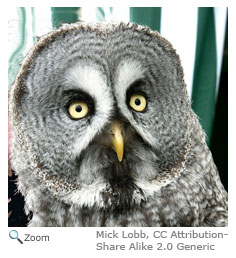 The Great gray Owl deserves its name because it is the largest owl in North America. It is between 24 and 33 inches and has a wingspan up to five feet! A dusty gray color, the Great Gray Owl has a large, flat facial disk and no ear tufts. A black spot on its chin surrounded with white marks on either side makes the Great Gray Owl look like it's wearing a bow tie. The Great gray Owl deserves its name because it is the largest owl in North America. It is between 24 and 33 inches and has a wingspan up to five feet! A dusty gray color, the Great Gray Owl has a large, flat facial disk and no ear tufts. A black spot on its chin surrounded with white marks on either side makes the Great Gray Owl look like it's wearing a bow tie.
Range
Found from Alaska through Canada, the Great Gray Owl is also found in Europe and Asia. In the continental United States, the owl is found in the higher Rocky Mountains and in Minnesota and northern Wisconsin.
Habitat
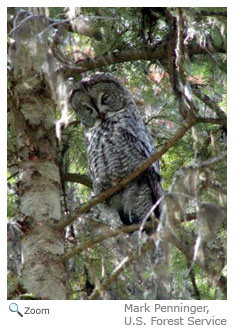 The Great Gray Owl is found in dense, coniferous forests in Canada and in mountain forests in the western United States. It prefers to make a nest in large, old pine and fir trees in spots far from human development. In the winter, the Great Gray Owl may live on the edge of woodlands, bordering open fields on which to hunt. It may also live near brackish tidal meadows. The Great Gray Owl is found in dense, coniferous forests in Canada and in mountain forests in the western United States. It prefers to make a nest in large, old pine and fir trees in spots far from human development. In the winter, the Great Gray Owl may live on the edge of woodlands, bordering open fields on which to hunt. It may also live near brackish tidal meadows. |
|
Diet
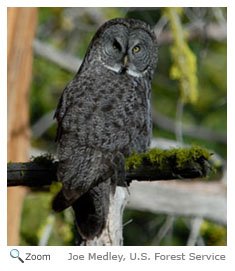 Most of the Great Gray Owl's diet is made up of small rodents like voles and pocket gophers. Occasionally, it will also eat small mammals, such as shrews, and birds. To hunt, the Great Gray Owl perches on a tree overlooking an open area. Good hearing allows the owl to accurately locate prey below several feet of snow. From its perch, the Great Gray Owl plunges through the snow to capture its prey. Most of the Great Gray Owl's diet is made up of small rodents like voles and pocket gophers. Occasionally, it will also eat small mammals, such as shrews, and birds. To hunt, the Great Gray Owl perches on a tree overlooking an open area. Good hearing allows the owl to accurately locate prey below several feet of snow. From its perch, the Great Gray Owl plunges through the snow to capture its prey.
Life Cycle
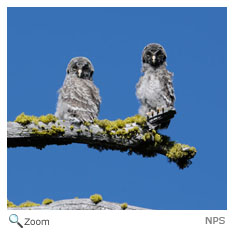 The Great Gray Owl lays eggs from March to June, depending on the temperature in its habitat. In a nest made of sticks, the female lays 2 to 5 white eggs. The female incubates the eggs for about 28 days. Both parents feed their young, tearing food into small pieces beforehand. Once the chicks replace their down with true feathers, they begin learning to fly. Chicks in this stage can be seen walking on the top of their nest flapping their wings. After three to four weeks, the chicks leave the nest for good. The Great Gray Owl lays eggs from March to June, depending on the temperature in its habitat. In a nest made of sticks, the female lays 2 to 5 white eggs. The female incubates the eggs for about 28 days. Both parents feed their young, tearing food into small pieces beforehand. Once the chicks replace their down with true feathers, they begin learning to fly. Chicks in this stage can be seen walking on the top of their nest flapping their wings. After three to four weeks, the chicks leave the nest for good.
Behavior
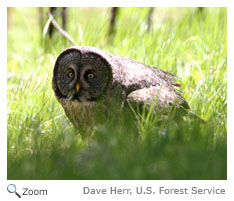 The Great Gray Owl is very reclusive and rarely seen by humans. Often, the only sign a Great Gray Owl is in the area is a "plunge mark", an imprint in the snow from which the owl has taken its prey. The Great Gray Owl is very reclusive and rarely seen by humans. Often, the only sign a Great Gray Owl is in the area is a "plunge mark", an imprint in the snow from which the owl has taken its prey.
Also, it can turn its head 270 degrees! |





